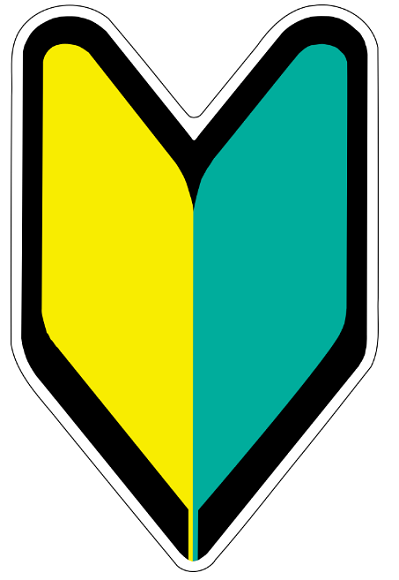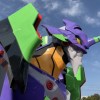Japan has a couple of unique automotive regulations. For example, every other year cars have to undergo an extensive inspection to make sure they’re being properly maintained and haven’t been illegally modified (although you can get away with some pretty interesting modifications in the 24 months between checks). You have to make a full stop at all railroad crossings, regardless of whether or not there’s a train coming.
For new drivers, there’s even an additional rule, which states that for their first year on the road, they have to put a large sticker on their car advising surrounding motorists to be extra careful. But while the law states the vehicle must bear two stickers, one on the front and one on the rear, there’s apparently no upper limit, as one proud owner recently demonstrated.
The stickers are called wakaba (“young leaf”) marks, and are patterned after a newly formed leaf in the vibrant colors of spring.
You most commonly find them along the front quarter panels and rear deck of the car.
The logic is that drivers with less experience are involved in more accidents, so the wakaba marks serve as a warning for others drivers to be especially cautious in their vicinity. The law’s the law, but, truth be told, a lot of people feel a little embarrassed about having to slap those stickers on their cars. For the owner of this Toyota Vitz, spotted by Twitter user Yamon, though, the wakaba mark seems to be a badge of pride, and he’s set out to slap as many as he can on his ride while still leaving enough space to arrange them in aesthetically pleasing patterns.
ガチ初心者や pic.twitter.com/WjWZhdTaWE
— やまん( ˙ω˙ )🤧 (@_yamanyaman) September 13, 2014
Internet users were similarly amused by the enthusiastic display.
“Beautiful.”
“Beginner-level itasha.”
“Beginner-level driver, master-level wakaba mark artist.”
“Man, I should have done this when I had to have them on my car!”
Silly as it may be, in the end this rolling artistic expression is still faithful to the intend purpose of the badges. “Yeah, I’d totally give this car a wide berth,” admitted one Internet commenter, which is exactly the effect the wakaba mark is designed to produce.
Source: Hamster Sokuho, Twitter
Insert images: Wikipedia/Chris Ruvolo


 Pizza Hut Japan’s hot lucky bags are perfect for a New Year’s pizza party
Pizza Hut Japan’s hot lucky bags are perfect for a New Year’s pizza party Cup Noodle tries an authentic Jiro-style ramen, but something’s not quite right
Cup Noodle tries an authentic Jiro-style ramen, but something’s not quite right Hayao Miyazaki says Happy New Year to Studio Ghibli fans with new art for Year of the Horse
Hayao Miyazaki says Happy New Year to Studio Ghibli fans with new art for Year of the Horse New form of luxurious poverty arrives at Japanese convenience stores with Tenkasu Gohan
New form of luxurious poverty arrives at Japanese convenience stores with Tenkasu Gohan Combining all of Nissin’s new Cup Noodle series into one powerful bowl of ramen
Combining all of Nissin’s new Cup Noodle series into one powerful bowl of ramen Pizza Hut Japan’s hot lucky bags are perfect for a New Year’s pizza party
Pizza Hut Japan’s hot lucky bags are perfect for a New Year’s pizza party Cup Noodle tries an authentic Jiro-style ramen, but something’s not quite right
Cup Noodle tries an authentic Jiro-style ramen, but something’s not quite right Hayao Miyazaki says Happy New Year to Studio Ghibli fans with new art for Year of the Horse
Hayao Miyazaki says Happy New Year to Studio Ghibli fans with new art for Year of the Horse New form of luxurious poverty arrives at Japanese convenience stores with Tenkasu Gohan
New form of luxurious poverty arrives at Japanese convenience stores with Tenkasu Gohan Combining all of Nissin’s new Cup Noodle series into one powerful bowl of ramen
Combining all of Nissin’s new Cup Noodle series into one powerful bowl of ramen That time Seiji called JASRAC to ask why he didn’t get paid royalties for his song being on TV
That time Seiji called JASRAC to ask why he didn’t get paid royalties for his song being on TV The 21st century Game Boy we wish Nintendo were working on【Pics】
The 21st century Game Boy we wish Nintendo were working on【Pics】 We visit the full-scale Evangelion statue in Kyoto and particularly delight in the food tie-ins
We visit the full-scale Evangelion statue in Kyoto and particularly delight in the food tie-ins Is it rude to sing along at concerts in Japan? We ask a pro musician for his take
Is it rude to sing along at concerts in Japan? We ask a pro musician for his take Harajuku’s new permanent Tamagotchi shop is filled with cuteness and a surprising lack of poop
Harajuku’s new permanent Tamagotchi shop is filled with cuteness and a surprising lack of poop Starbucks Japan ready to get Year of the Horse started with adorable drinkware and plushies【Pics】
Starbucks Japan ready to get Year of the Horse started with adorable drinkware and plushies【Pics】 7 great places to see Mt. Fuji from without having to climb it
7 great places to see Mt. Fuji from without having to climb it Cyberpunk anime meets traditional culture in Ghost in the Shell gold leaf Japanese changing screens
Cyberpunk anime meets traditional culture in Ghost in the Shell gold leaf Japanese changing screens Hello Kitty Choco Egg figures are an adorable trip through three periods of Japanese pop culture【Pics】
Hello Kitty Choco Egg figures are an adorable trip through three periods of Japanese pop culture【Pics】 We found possibly the quietest Japanese-style hotel in Tokyo’s bustling Shinjuku district
We found possibly the quietest Japanese-style hotel in Tokyo’s bustling Shinjuku district 7-Eleven Japan’s ramen-cooking robot whipped us up a bowl of noodles【Taste test】
7-Eleven Japan’s ramen-cooking robot whipped us up a bowl of noodles【Taste test】 Sumo Sanrio! Hello Kitty and pals team up with Japan Sumo Association for new merch【Pics】
Sumo Sanrio! Hello Kitty and pals team up with Japan Sumo Association for new merch【Pics】 Japan’s oldest largetooth sawfish in captivity back on display in Mie Prefecture
Japan’s oldest largetooth sawfish in captivity back on display in Mie Prefecture More Than a Capsule Stay: Why Solo Travelers Choose “global cabin Yokohama Chinatown”
More Than a Capsule Stay: Why Solo Travelers Choose “global cabin Yokohama Chinatown” 7-Eleven Japan starts new temporary luggage storage service in over 300 branches
7-Eleven Japan starts new temporary luggage storage service in over 300 branches Disillusionment at Tsukiji’s tourist-target prices led us to a great ramen restaurant in Tokyo
Disillusionment at Tsukiji’s tourist-target prices led us to a great ramen restaurant in Tokyo Starbucks teams up with 166-year-old Kyoto doll maker for Year of the Horse decorations【Photos】
Starbucks teams up with 166-year-old Kyoto doll maker for Year of the Horse decorations【Photos】 Tokyo considering law requiring more trash cans following litter increase in heavily touristed area
Tokyo considering law requiring more trash cans following litter increase in heavily touristed area Tokyo’s Tsukiji sushi neighborhood asks tour groups to stay away for the rest of the month
Tokyo’s Tsukiji sushi neighborhood asks tour groups to stay away for the rest of the month Tokyo event lets you travel back in time, for free, to celebrate 100 years since Showa era start
Tokyo event lets you travel back in time, for free, to celebrate 100 years since Showa era start Sanrio theme park in Japan announces plans to expand into a Sanrio resort
Sanrio theme park in Japan announces plans to expand into a Sanrio resort Japan may add Japanese language proficiency, lifestyle classes to permanent foreign resident requirements
Japan may add Japanese language proficiency, lifestyle classes to permanent foreign resident requirements Stamina-destroying “Paralysis Noodles” are Tokyo’s newest over-the-top ramen innovation
Stamina-destroying “Paralysis Noodles” are Tokyo’s newest over-the-top ramen innovation Survey asks foreign tourists what bothered them in Japan, more than half gave same answer
Survey asks foreign tourists what bothered them in Japan, more than half gave same answer Japan’s human washing machines will go on sale to general public, demos to be held in Tokyo
Japan’s human washing machines will go on sale to general public, demos to be held in Tokyo Japan’s deadliest food claims more victims, but why do people keep eating it for New Year’s?
Japan’s deadliest food claims more victims, but why do people keep eating it for New Year’s? We deeply regret going into this tunnel on our walk in the mountains of Japan
We deeply regret going into this tunnel on our walk in the mountains of Japan Studio Ghibli releases Kodama forest spirits from Princess Mononoke to light up your home
Studio Ghibli releases Kodama forest spirits from Princess Mononoke to light up your home Major Japanese hotel chain says reservations via overseas booking sites may not be valid
Major Japanese hotel chain says reservations via overseas booking sites may not be valid Put sesame oil in your coffee? Japanese maker says it’s the best way to start your day【Taste test】
Put sesame oil in your coffee? Japanese maker says it’s the best way to start your day【Taste test】 No more using real katana for tourism activities, Japan’s National Police Agency says
No more using real katana for tourism activities, Japan’s National Police Agency says Starbucks Japan reveals new sakura drinkware collection, inspired by evening cherry blossoms
Starbucks Japan reveals new sakura drinkware collection, inspired by evening cherry blossoms Updated cherry blossom forecast shows extra-long sakura season for Japan this year
Updated cherry blossom forecast shows extra-long sakura season for Japan this year That time Seiji called JASRAC to ask why he didn’t get paid royalties for his song being on TV
That time Seiji called JASRAC to ask why he didn’t get paid royalties for his song being on TV The 21st century Game Boy we wish Nintendo were working on【Pics】
The 21st century Game Boy we wish Nintendo were working on【Pics】 We visit the full-scale Evangelion statue in Kyoto and particularly delight in the food tie-ins
We visit the full-scale Evangelion statue in Kyoto and particularly delight in the food tie-ins Is it rude to sing along at concerts in Japan? We ask a pro musician for his take
Is it rude to sing along at concerts in Japan? We ask a pro musician for his take Harajuku’s new permanent Tamagotchi shop is filled with cuteness and a surprising lack of poop
Harajuku’s new permanent Tamagotchi shop is filled with cuteness and a surprising lack of poop Can Daiso’s mini washing machine wash your jocks and socks?
Can Daiso’s mini washing machine wash your jocks and socks? Stay in an eerie Japanese ryokan inn near Tokyo Tower for US$40 a night
Stay in an eerie Japanese ryokan inn near Tokyo Tower for US$40 a night Take it From a Native! Recipe for Delicious Japanese Curry as Found at Coco Ichiban
Take it From a Native! Recipe for Delicious Japanese Curry as Found at Coco Ichiban Japanese convenience store packs a whole bento into an onigiri rice ball
Japanese convenience store packs a whole bento into an onigiri rice ball The best Starbucks Japan Frappuccinos we want to drink again in 2026
The best Starbucks Japan Frappuccinos we want to drink again in 2026 We test the cleaning power of the miniature washing machine from 100 yen shop Daiso
We test the cleaning power of the miniature washing machine from 100 yen shop Daiso Coca-Cola Japan unveils new sakura design bottle for cherry blossom season 2020
Coca-Cola Japan unveils new sakura design bottle for cherry blossom season 2020 Studio Ghibli releases wallpapers for Ghibli Park, introduces us to two new forest characters
Studio Ghibli releases wallpapers for Ghibli Park, introduces us to two new forest characters
Leave a Reply